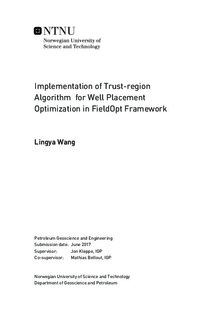Implementation of Trust-region Algorithm for Well Placement Optimization in FieldOpt Framework
Master thesis
Permanent lenke
http://hdl.handle.net/11250/2453091Utgivelsesdato
2017Metadata
Vis full innførselSamlinger
Sammendrag
Oil field development is a challenging engineering task that involves optimizationproblems such as the types, numbers, scheduling, location, and controls of wells.Optimization algorithm is the keyfactor for optimization model. Each algorithmhas its own strengths and weaknesses, hence we need to apply efficent andeffective methodologies to solve optimizatiom problems. This thesis concernsthe implementation of local search trust-region derivative-free algorithm for wellplacement into the FieldOpt optimization framework developed at the PetroleumCybernetics Group, NTNU.The C++-written FieldOpt software program serves as a framework andenabler for algorithm development aimed at petroleum problems that require theefficient computations of reservoir simulations for cost function evaluation. Thereservoir simulation works as a Black Box , but the FieldOpt software allows fora straightforward one-to-one communication between the algorithm logic and themultiple driver files and settings needed by the simulator.We start with general introduction of well placement optimization and widelyused algorithms for optimizaton problems. Gradients with respect to well place-ment variables are commonly not available and therefore derivative-free methodsare often proposed for well placement optimization. The trust region methodimplemented in this work does not require cost function derivatives, but insteadconstructs surrogate models of the objective function obtained during the optimiza-tion process. Our approach is based on building a quadratic interpolation model,which reasonably reflects the local behavior of the original objective function in asubregion.After implementation of the algorithm in FieldOpt, we apply test functionsto validate the performance of the algorithm. One of them is the plated-shapedMatyas function and the other one is the valley-shaped Rosen-brock function.We used Cauchy point calculation and Dogleg method to solve the optimizationproblem and analyzed their convergence properties. The results show that theconvergence of the Cauchy point algorithm by taking the steepest descent directionis inefficient in some cases. A future improvement could be achieved by usingthe Dogleg method. We also notice that values of predetermined parameterscan affect algorithm performance. Therefore, it is also important to choose aproper parameter value to improve the convergence of method. Then, we applythe model-based trust-region method to solve some well placement optimizationcases, for exapmle single producer or five-spot model.
